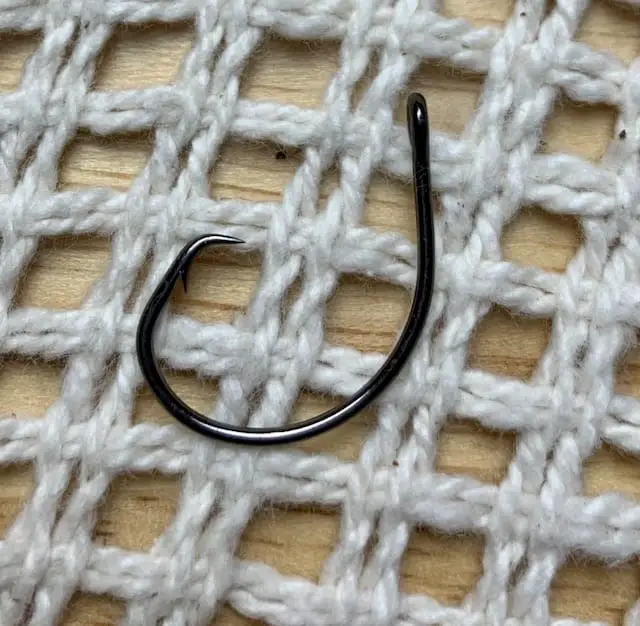What is a Circle Hook?
A circle hook is a type of fishing hook where the point makes a 90 degree angle with the shank, or is perpendicular to the shank. A circle hook is known for catching in the corner of a fish's mouth as it turns away after a strike, which minimizes the damage to the fish. This characteristic makes circle hooks the optimum choice for catch-and-release fishing.
In the photo below, you can see the different parts of the hook called out and you can easily see that the circle hook point is pointing directly at the shaft. The eye is the part of the hook that the leader or line is tied to, and the shank is the backbone of the hook, giving it structure. The bend on the bottom is the curvature which makes it a hook and the barb is the sharp portion sticking out near the point which prevents the hook from sliding out after penetration. The barb can also make sure that your bait doesn't slide off. The point is usually the sharpest and thinnest part of the hook since it has the important job of penetrating the flesh. The gap is the amount of space between the point and the shank giving space for bait.
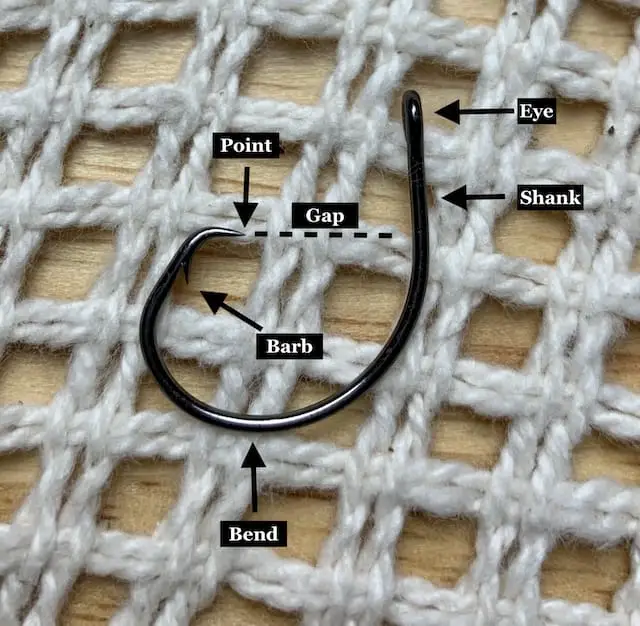
Light Wire and Heavy Wire Circle Hooks
Light wire circle hooks are thinner in diameter and tend to be sharper at the point. This makes penetration of flesh very easy. Heavy wire hooks are thicker and require more force to penetrate the flesh. For a circle hook, the drag setting on your line is most likely going to be what gives it more or less force, since you're not actively setting the hook. If you like a heavier drag setting, you can opt for a heavier wire circle hook and get just as many hookups as an angler with a light wire and lighter drag setting. In the photo below, you can see the difference in thickness of a light wire and a heavy wire hook. You'll also want to consider the mouth of the fish you're targeting. For example, a tarpon has a hard mouth making penetration difficult, so you'll want to opt for a strong light wire hook.
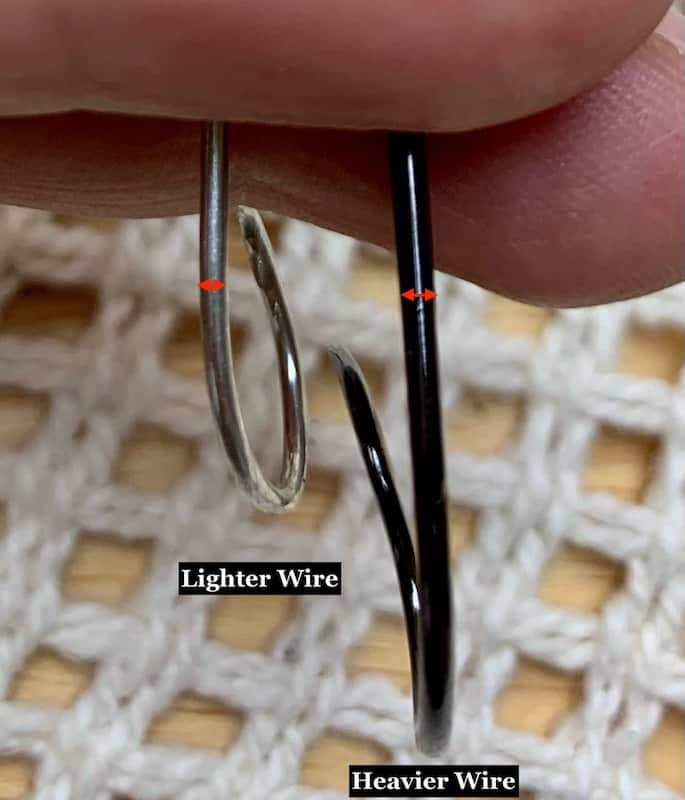
When anglers are asked about their preference between light wire and heavy wire hooks, it's often discussed in the context of J hooks and a fisherman's hook setting habits. For a circle hook, however, the light wire tends to be the optimum choice when you're casting out a long distance in pretty clear water (minimal weeds and structure). The heavy wire circle hook is the better choice when casting nearby on a day with heavy weeds. This is because the light wire hooks can flex and bend and are more likely to be straightened out if you tug them out of weeds.
Octopus Circle vs Straight Eye Circle
When scrolling through the hook aisle at your local tackle shop or sporting goods store, you'll see a lot of what are called “octopus circle” hooks. If you're wondering what that means, look at the differences in the eye angle in the photo below.
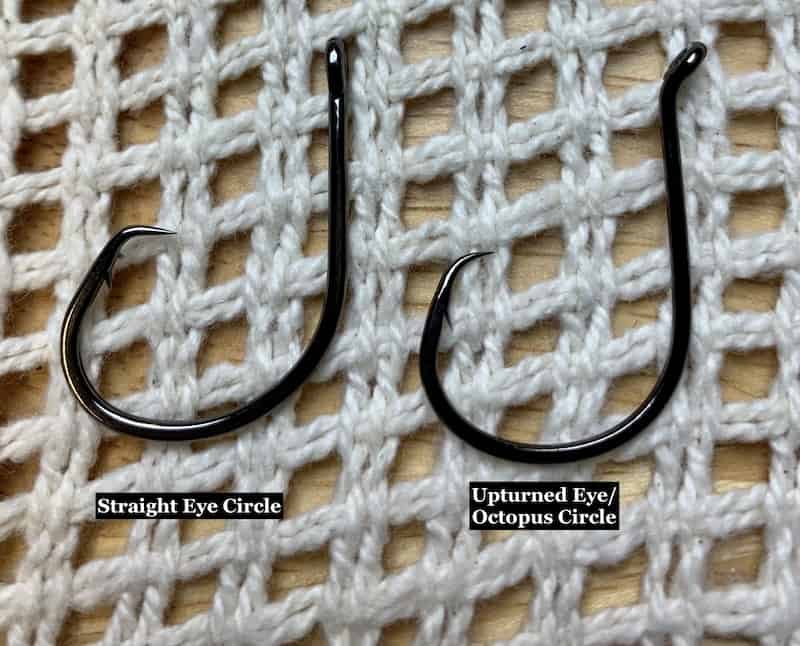
You can see a straight eye circle hook has the eye in alignment with the shank and the octopus circle with an “up” eye has the eye angled back. The difference comes into play with how you plan to rig the hook. If you plan on using a snell knot, you'll want to still keep the hook in the right alignment with your line, which can only be done if you use an octopus hook.
Here is our recommendation for an upturned eye non-offset hook:
- Eye Up, Inline (non-offset), Circle Hook
Tournament Legal or Tournament Approved Hooks
To understand what Tournament Legal or Tournament Approved hooks are, you need to first understand the relevant fishing gear rules and why they exist. Particularly for Florida, here are the laws in regards to hook use for reef fish. Note: 28° North latitude is approximately near Melbourne, FL.
State Waters of the Gulf of Mexico Required Gear
When fishing with natural bait, non-stainless steel, non-offset circle hooks are required
Gulf federal waters
When fishing with natural bait, non-stainless steel circle hooks are required
State Waters of the Atlantic Required Gear
When fishing for reef fish using hook-and-line gear and natural baits, the following hooks are required
North of 28° North latitude: non-offset, non-stainless-steel circle hooks.
South of 28° North latitude: non-stainless-steel hooks.
Atlantic federal waters
When fishing for reef fish using hook-and-line gear and natural baits, the following hooks are required (also see map):
North of 28° North latitude: non-offset, non-stainless-steel circle hooks.
South of 28° North latitude: non-stainless-steel hooks.
Source: https://myfwc.com/fishing/saltwater/recreational/gear-rules/
The reason these laws exist is to conserve the fish population. The objective is for anglers to be able to catch-and-release fish without damaging the fish so much that it cannot survive. Natural bait is called out in these laws because a fish is more likely to swallow a hook with natural bait in comparison to artificial bait. The best way to improve a fish's survivability is to hook it in its mouth, which is already likely with artificial bait, but hook use laws need to be specified when using natural (live or dead) bait.
Non-stainless steel hooks are specified because they will degrade faster than others. Although corrosion resistance might be an advantage in the eyes of the fisherman, the inability of the hook to degrade makes it less likely for a fish to pass it if a line were to break and the hook remain in the fish, ref. FWC news.
Offset hooks have the point slightly offset from straight alignment with the shank and are more likely to result in a throat or gut hook. For this reason, the non-offset, or inline, circle hooks are required for reef fish to preserve their populations.
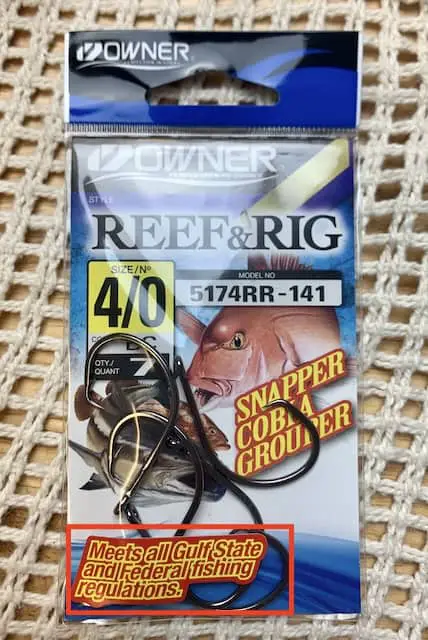
Now if you were in the store trying to find a hook that was in alignment with these laws, or looking for a hook to use in an upcoming tournament targeting reef fish, you can look for something like what's in the photo above, “Meets all Gulf State and Federal fishing regulations” or look for a non stainless steel, non offset circle hook. These hooks are also considered the best hooks for catch and release fishing, which you can read more about in our article here: Choosing Best Hook for Catch and Release Fishing. The only additional thing we recommend for catch-and-release fishing, is using some pliers to crimp down the barb which will make it even easier to minimize the fish handling time.
Here are some of our recommendations for inline non-offset circle hooks:
- Straight Eye, Inline (non-offset), Circle Hook (Tournament Legal)
Non-offset/Inline vs Offset
A circle hook with an offset is one in which the alignment of the hook bend and point does not match that of the shank. In the photo below, you can see how the point is turned slightly off center, and the packaging has an “offset” indication highlighted by the red box. These hooks may increase your hookup ratio, but shouldn't be used for catch-and-release fishing since they have an increased likelihood of a throat, gill, or gut hook. These still perform better in regards to mouth hookups when compared to something like a kahle hook or J hook.
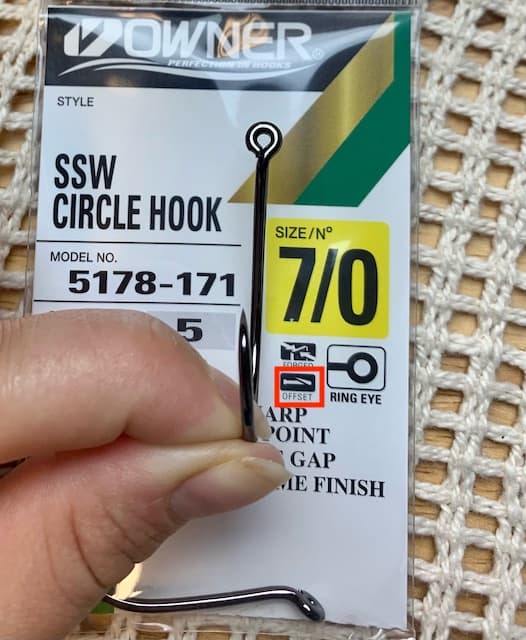
You can choose to use a straight eye, or an up eye configuration when you purchase an offset circle hook, and here are a couple of our recommendations from Tackle Direct:
- Straight Eye, Offset, Circle Hook
- Eye Up, Offset, Circle Hook
WIth all of the hook variations out there on the market, it can sometimes be confusing what the differences are. If you can't quite remember the difference between a circle hook and kahle hook, read through the piece we put together on it: Circle Hook vs Kahle Hook. Essentially the difference is the direction that the point points. A circle hook points directly at the shank, but for a kahle hook, the point points at the eye.
We put together a video going over these circle hook configuration options, take a look here (and don't forget to subscribe!):
How to Choose the Right Circle Hook
We've talked about the circle hook configurations now, so you should have a pretty good idea of which configuration is best for your application, e.g. light wire non-offset, non stainless steel circle hook if you're casting far with minimal weeds. The last remaining choice is in regards to the size of the hook. So, if you were planning to go out and surf fish and target pompano, what size hook would you choose?
The best way to choose the size of the hook is to consider the bait you'll be using and select a size that supports it. If you read through our article, Best Size Hook for Pompano Fishing, you'll see that a 1/0 circle hook is best when using fish bites as bait and a 2/0 is best when using sand fleas as bait, because of the size difference. Both are relatively small hooks since the mouth of a pompano is pretty small.
You'll also want to consider the size of the fish, although your bait size typically also considers the size of the fish, so it's difficult to separate the two. For example, if you're surf fishing and targeting a pompano with a small mouth, you'll choose a smaller hook (1/0 or 2/0) and smaller bait than if you were targeting tarpon from the beach with mullet as bait likely using a 9/0 hook.
Hope you enjoyed the article! Tight lines, y'all!
Recent Posts
Fat Cow Jig Strips: The Ultimate Bucktail Jig Upgrade for Surf Fishing
As discussed in my previous article, "Surf Fishing with Bucktail Jigs: Ultimate Guide for Beach Anglers," bucktail jigs are a staple in any surf angler's tackle box, offering a versatile way to catch...
In my previous article, "Surf Fishing with Bucktail Jigs: Ultimate Guide for Beach Anglers," I introduced you to the bucktail jig and discussed how versatile of a lure it is for catching a wide range...

